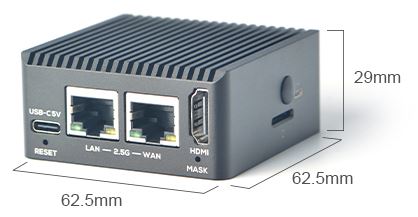3 FriendlyElec NanoPi R5C
Contents
3.1 Board Overview
The NanoPi R5C is an open-source mini IoT gateway device with two 2.5 Gbit, designed and developed by FriendlyElec. It is integrated with Rockchip RK3568B2 CPU, 1/2/4 GB LPDDR4X RAM and 8 or 32 GB eMMC flash. The NanoPi R5C has rich hardware resources with a compact size of 58 × 58 mm.
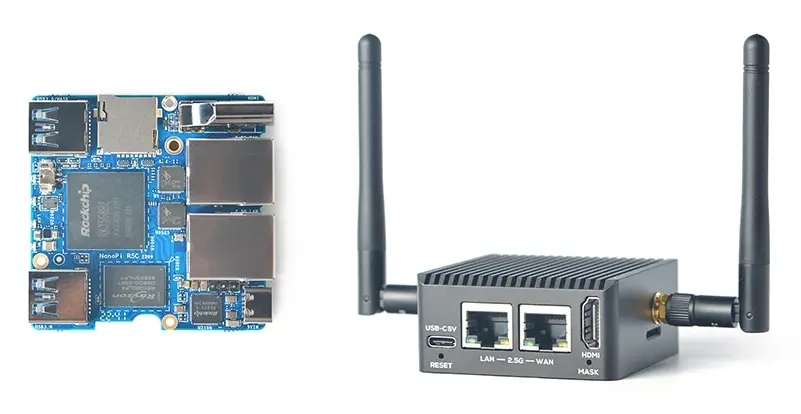
Fig. 3.8 FriendlyElec NanoPi R5C
3.1.1 Board Layout
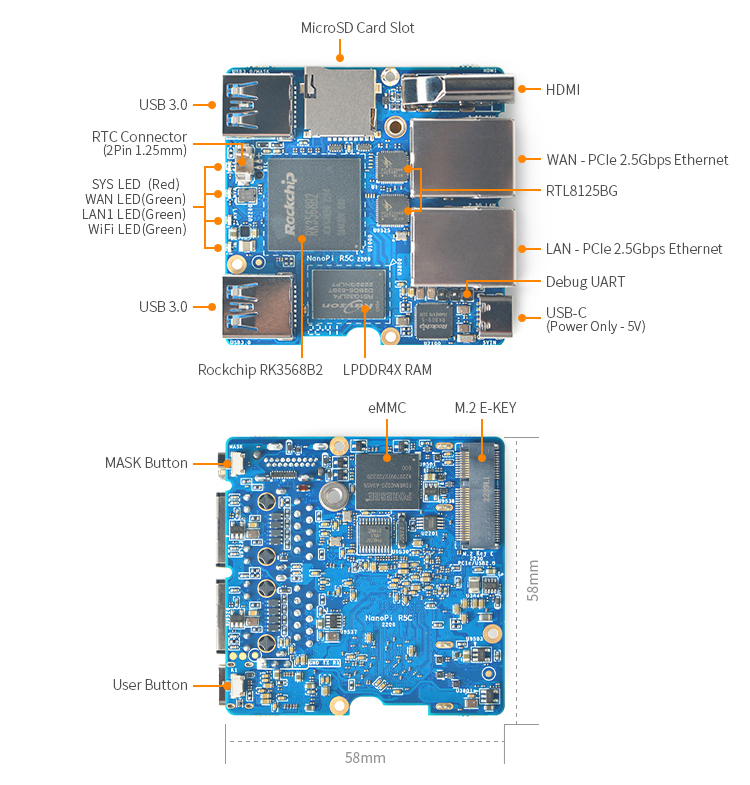
Fig. 3.9 FriendlyElec NanoPi R5C Layout
3.1.2 Photos
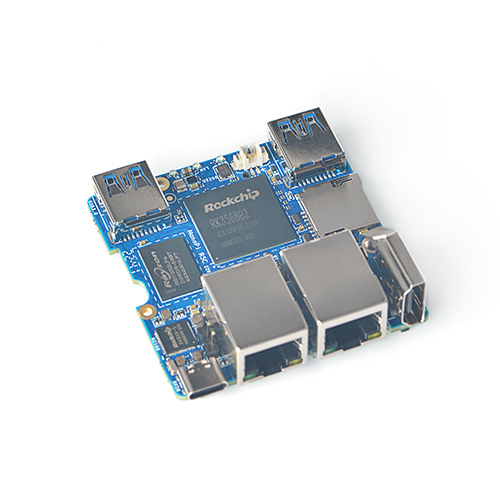
Fig. 3.10 FriendlyElec NanoPi R5C Board Overview
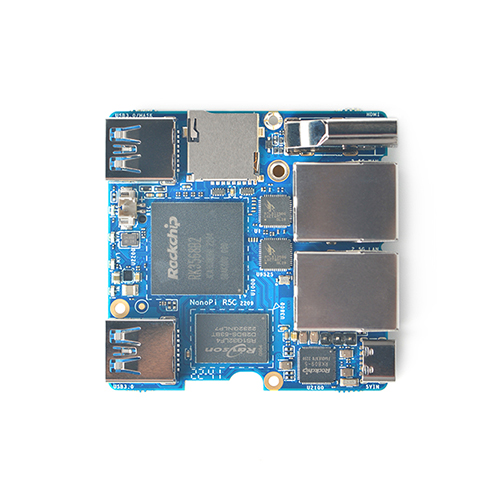
Fig. 3.11 FriendlyElec NanoPi R5C Board Front View
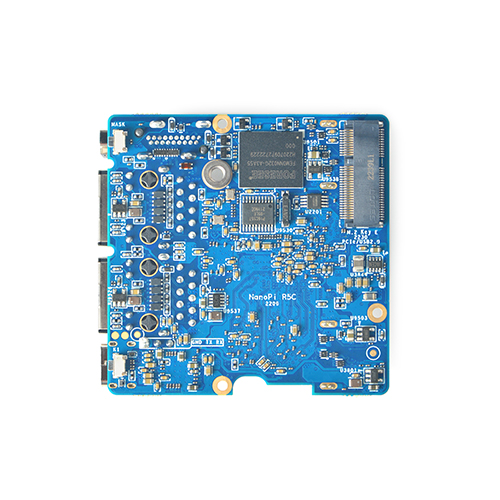
Fig. 3.12 FriendlyElec NanoPi R5C Board Back View
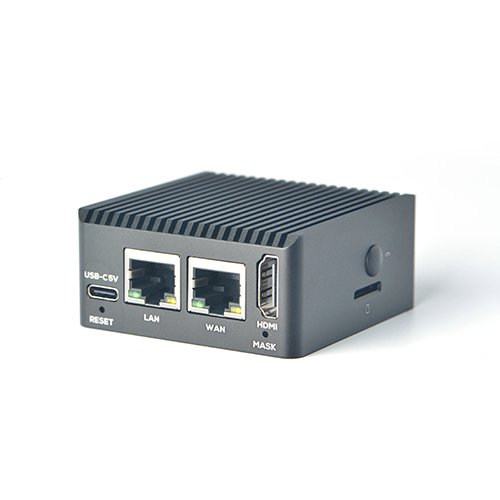
Fig. 3.13 FriendlyElec NanoPi R5C Case Overview
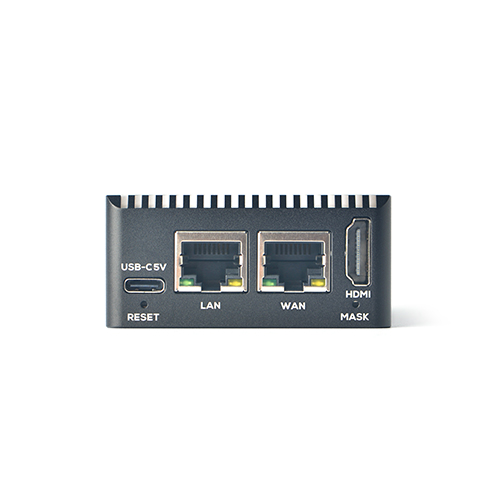
Fig. 3.14 FriendlyElec NanoPi R5C Case Front View
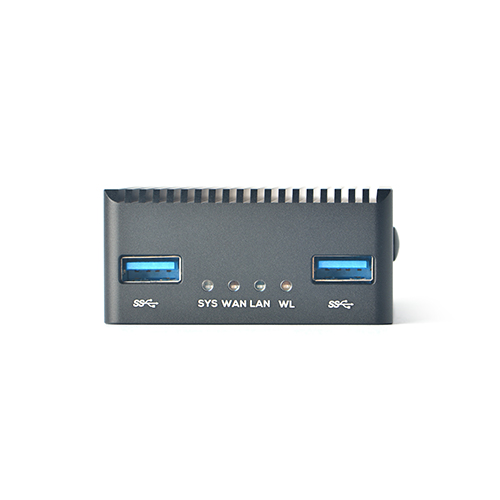
Fig. 3.15 FriendlyElec NanoPi R5C Case Back View
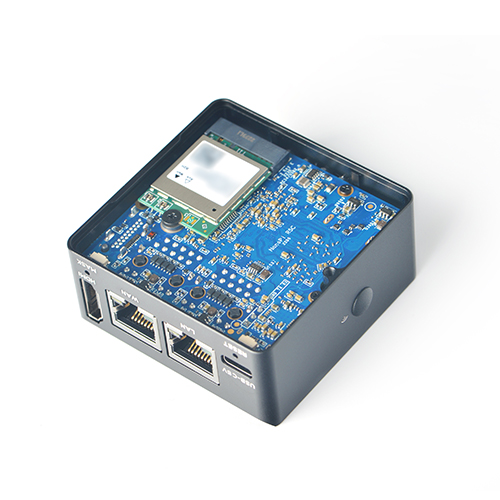
Fig. 3.16 FriendlyElec NanoPi R5C Opened Case
3.1.3 Specification
Model |
FriendlyElec NanoPi R5C |
|---|---|
Processor |
SoC Rockchip RK3568
Quad Cortex-A55 ARM 64 bits processor
frequency up to 2.0 GHz
|
GPU |
RM Mali-G52 GPU with support for OpenGL ES 1.1/2.0/3.2, OpenCL 2.0, Vulkan 1.1 |
NPU |
0.8 TOPS |
Memory |
4 GiB LPDDR4X |
Storage |
microSD (support UHS-I)
8 GiB eMMC flash (up to 128 GiB)
|
Ethernet |
2 × 2.5 Gigabit Ethernet RJ45 ports
|
PCI Express |
1 × M.2 Key E 2230: PCIe 2.1 x1, USB 2.0 x1 (supports M.2 WiFi,
SSD and Bluetooth modules)
|
USB (Host) |
2 × USB 3.2 Gen 1 Type-A ports |
Serial |
1 × Debug UART (3 pin 2.54 mm header, 3.3V level, 1500000 bps) |
HDMI |
Support HDMI 1.4 and HDMI 2.0 operation
Support up to 10 bits deep color modes
Support up to 1080p@120 Hz and 4096x2304@60 Hz
Support 3D video formats
|
LED’s |
4 × GPIO controlled LED’s (SYS, WAN, LAN, WL) |
Power |
USB-C 5V input |
Working temperature |
0°C to 70°C |
Dimensions |
3.2 Build Targets
3.2.1 Machines
Board1 |
Target YAML2 |
Machine3 |
Target Recipe(s)4 |
Running Media5 |
Installation Media6 |
|---|---|---|---|---|---|
NanoPi R5C |
|
|
|
microSD card |
– |
|
|
|
internal eMMC |
microSD card |
- 1
Target board.
- 2
Target YAML-file located in the
kas/targetsdirectory.- 3
Target machine name stored in the
MACHINEBitBake variable for selected Target YAML.- 4
Recipes that will be built by default for the target. In Section 3.2.2, you can find list of supported recipes for the target images, which you can build in addition to the default recipes using optional
--targetoption in build command (see Section 3.3).- 5
External or internal data storage where the TanoWrt operating system is running.
- 6
External storage device for which an installation image is generated. When booting from the Installation Media, the TanoWrt system is installed on the Running Media storage.
3.2.2 Images
Read-Only Root Filesystem Image |
Recipe7 |
Supported by Target(s) |
Description |
|---|---|---|---|
|
|
All |
Standard TanoWrt image. |
|
All |
Standard TanoWrt image
and firmware upgrade
image. When building this image,
|
|
|
|
Factory installation image for standard TanoWrt
image. When building this image,
|
|
|
|
All |
Standard TanoWrt image with Qt5 support. |
|
All |
Standard TanoWrt image with Qt5 support
and firmware upgrade
image. When building this image,
|
|
|
|
Factory installation image for standard TanoWrt
image with Qt5 support. When building this image,
|
- 7
Image recipe name. This name can be used as argument for
--targetbuild command option (see Section 3.3 section).
3.3 Build
Please read the common information on how to perform a TanoWrt images build and preparing the build environment in section “Building TanoWrt”.
See also
See section Section 3.2.1 to select the required target YAML file (
<target-yml>).See section Section 3.2.2 to select the required root filesystem image recipe (
<target-recipe>).See section Section 3.5 for detailed information about the produced build artifacts.
3.3.1 Examples
3.3.1.1 Build Default Images for NanoPi R5C Board
For microSD Card
$ kas build targets/kas/nanopi-r5c-sd.yml
Default images will be produced to boot and run from the microSD card on the FriendlyElec NanoPi R5C target board.
For Internal eMMC Flash
$ kas build targets/kas/nanopi-r5c-emmc.yml
An initial factory installation image will be generated, intended to run from the microSD card. The installer image will install the default image to the internal eMMC flash memory and further the NanoPi R5C board will boot and run from the eMMC flash memory.
3.3.1.2 Build Image with Qt5 Support for NanoPi R5C Board
For SD Card
$ kas build --target twimg-qt5-swu targets/kas/nanopi-r5c-sd.yml
Images with Qt5 support will be produced to boot and run from the SD card on the NanoPi R5C target board.
For Internal eMMC Flash
$ kas build --target twimg-qt5-swu-factory targets/kas/nanopi-r5c-emmc.yml
An initial factory installation image will be generated, intended to run from the SD card. The installer image will install the image with Qt5 support to the internal eMMC flash memory and further the NanoPi R5C board will boot and run from the eMMC flash memory.
3.4 Partitioning Layouts
Images for NanoPi R5C board using default partitions layouts described here.
For example, the partitioning and data layout for the 32 GB eMMC are shown in the figure below.
Fig. 3.17 FriendlyElec NanoPi R5C Partitions Layout for eMMC (32 GB)
The eMMC hardware boot partitions 1 (/dev/mmcblk0boot0) and
2 (/dev/mmcblk0boot1) are currently not used.
3.5 Produced Build Artifacts
All produced build artifacts are stored in the ~/tanowrt/build/tanowrt-glibc/deploy/images/<MACHINE> directory.
Refer to table Produced Build Artifacts for a description of some common (not all) build artifacts.
Artifact |
Target(s) |
Description |
|---|---|---|
Bootloader |
||
|
All |
Rockchip IDBLOCK image for booting from SD card. |
|
|
Rockchip IDBLOCK image for booting from internal eMMC. |
Bootloader (U-Boot) |
||
|
All |
U-Boot startup script. |
|
|
U-Boot startup script for factory installation image. |
|
All |
U-Boot initial environment image for SD card image. |
|
|
U-Boot initial environment image for internal eMMC flash. |
|
All |
U-Boot binary image for booting from SD card. |
|
|
U-Boot binary image for booting from internal eMMC flash. |
Linux Kernel and DTB |
||
|
All |
Flattened Image Tree (FIT) image with Linux kernel and Device Tree Blobs (DTB). |
|
All |
FIT image packed into an ext4 file system image. |
rk3568-nanopi5-rev01-<MACHINE>.dtbrk3568-nanopi5-rev02-<MACHINE>.dtbrk3568-nanopi5-rev03-<MACHINE>.dtbrk3568-nanopi5-rev04-<MACHINE>.dtbrk3568-nanopi5-rev05-<MACHINE>.dtbrk3568-nanopi5-rev07-<MACHINE>.dtb |
All |
Target Device Tree Blobs (DTB). |
Images |
||
|
|
SD card image including all required partitions for booting and running the system. This image is ready to be written to the SD card using the dd utility or similar (see Writing Images). |
|
|
SD card factory installation image. This image is ready to be written to the SD card using the dd utility or similar (see Writing Images). |
|
All |
Root filesystem image (squashfs with LZO compression). |
|
All |
Firmware upgrade image. |
Note
<MACHINE> in the artifacts path and artifact file names are replaced by
the actual value of the MACHINE BitBake variable for the chosen
target. <rootfs-image> is replaced
by the actual read-only root filesystem image name.
For example, below is the complete lists of artifacts produced by the nanopi-r5c-sd.yml
and nanopi-r5c-sd.yml target builds. There are two types of listings here —
a complete listing, and a reduced listing without the symbolic links display.
3.5.1 Build Artifacts Listings for nanopi-r5c-sd.yml Target
[~/tanowrt/build/tanowrt-glibc/deploy/images/nanopi-r5c-sd]$ ls -gGh | grep -v -e "^l"
total 291M
-rw-r--r-- 2 12M May 14 08:35 fitImage--6.1.57+git0+ea9e2a9344-tano0.2.1.20.1.0-nanopi-r5c-sd-20240514020944.bin
-rw-r--r-- 2 15M May 14 08:35 fitImage-6.1.57+gitAUTOINC+ea9e2a9344-tano0.2.1.20.1.0-nanopi-r5c-sd.ext4
-rw-r--r-- 2 5.8K May 14 08:35 fitImage-its--6.1.57+git0+ea9e2a9344-tano0.2.1.20.1.0-nanopi-r5c-sd-20240514020944.its
-rw-r--r-- 2 11M May 14 08:35 fitImage-linux.bin--6.1.57+git0+ea9e2a9344-tano0.2.1.20.1.0-nanopi-r5c-sd-20240514020944.bin
-rw-r--r-- 2 15M May 14 08:35 fitImage-nanopi-r5c-sd.ext4
-rwxr-xr-x 2 256K May 14 08:35 idblock.img-nanopi-r5c-sd-sdcard-2017.09+gitAUTOINC+4695fbcfba_642a85dd55
-rwxr-xr-x 2 415K May 14 08:35 loader.bin-nanopi-r5c-sd-sdcard-2017.09+gitAUTOINC+4695fbcfba_642a85dd55
-rw-r--r-- 2 2.6M May 14 08:35 modules--6.1.57+git0+ea9e2a9344-tano0.2.1.20.1.0-nanopi-r5c-sd-20240514020944.tgz
-rw-r--r-- 2 171K May 14 08:35 rk3568-nanopi5-rev01--6.1.57+git0+ea9e2a9344-tano0.2.1.20.1.0-nanopi-r5c-sd-20240514020944.dtb
-rw-r--r-- 2 170K May 14 08:35 rk3568-nanopi5-rev02--6.1.57+git0+ea9e2a9344-tano0.2.1.20.1.0-nanopi-r5c-sd-20240514020944.dtb
-rw-r--r-- 2 170K May 14 08:35 rk3568-nanopi5-rev03--6.1.57+git0+ea9e2a9344-tano0.2.1.20.1.0-nanopi-r5c-sd-20240514020944.dtb
-rw-r--r-- 2 170K May 14 08:35 rk3568-nanopi5-rev04--6.1.57+git0+ea9e2a9344-tano0.2.1.20.1.0-nanopi-r5c-sd-20240514020944.dtb
-rw-r--r-- 2 171K May 14 08:35 rk3568-nanopi5-rev05--6.1.57+git0+ea9e2a9344-tano0.2.1.20.1.0-nanopi-r5c-sd-20240514020944.dtb
-rw-r--r-- 2 172K May 14 08:35 rk3568-nanopi5-rev07--6.1.57+git0+ea9e2a9344-tano0.2.1.20.1.0-nanopi-r5c-sd-20240514020944.dtb
-rw-r--r-- 2 2.3K May 14 08:35 startup.img
-rw-r--r-- 2 16 May 14 08:35 startup.img.version
-rw-r--r-- 2 70K May 14 08:35 twimg-default-nanopi-r5c-sd-20240514020944.rootfs.manifest
-rw-r--r-- 2 945M May 14 08:37 twimg-default-nanopi-r5c-sd-20240514020944.rootfs.sdcard.img
-rw-r--r-- 2 48M May 14 08:36 twimg-default-nanopi-r5c-sd-20240514020944.rootfs.squashfs-lzo
-rw-r--r-- 2 24 May 14 08:37 twimg-default-nanopi-r5c-sd-20240514020944.rootfs.version
-rw-r--r-- 2 354K May 14 08:35 twimg-default-nanopi-r5c-sd-20240514020944.testdata.json
-rw-r--r-- 2 2.2K May 14 08:36 twimg-default-sdimage-rockchip-swu-a-b.wks
-rw-r--r-- 2 65M May 14 08:38 twimg-default-swu-nanopi-r5c-sd-20240514020944.swu
-rw-r--r-- 2 5.7K May 14 08:36 twimg-default.env
-rw-r--r-- 2 405 May 14 08:35 u-boot-initial-env-nanopi-r5c-sd-sdcard-2017.09+gitAUTOINC+4695fbcfba_642a85dd55-tano13
-rw-r--r-- 2 32K May 14 08:35 u-boot-initial-env-nanopi-r5c-sd-sdcard-2017.09+gitAUTOINC+4695fbcfba_642a85dd55-tano13.bin
-rw-r--r-- 2 2.0M May 14 08:35 u-boot-sdcard-2017.09+gitAUTOINC+4695fbcfba_642a85dd55-tano13.bin
[~/tanowrt/build/tanowrt-glibc/deploy/images/nanopi-r5c-sd]$ ls -gGh
total 291M
lrwxrwxrwx 2 82 May 14 08:35 fitImage -> fitImage--6.1.57+git0+ea9e2a9344-tano0.2.1.20.1.0-nanopi-r5c-sd-20240514020944.bin
-rw-r--r-- 2 12M May 14 08:35 fitImage--6.1.57+git0+ea9e2a9344-tano0.2.1.20.1.0-nanopi-r5c-sd-20240514020944.bin
-rw-r--r-- 2 15M May 14 08:35 fitImage-6.1.57+gitAUTOINC+ea9e2a9344-tano0.2.1.20.1.0-nanopi-r5c-sd.ext4
-rw-r--r-- 2 5.8K May 14 08:35 fitImage-its--6.1.57+git0+ea9e2a9344-tano0.2.1.20.1.0-nanopi-r5c-sd-20240514020944.its
lrwxrwxrwx 2 86 May 14 08:35 fitImage-its-nanopi-r5c-sd -> fitImage-its--6.1.57+git0+ea9e2a9344-tano0.2.1.20.1.0-nanopi-r5c-sd-20240514020944.its
-rw-r--r-- 2 11M May 14 08:35 fitImage-linux.bin--6.1.57+git0+ea9e2a9344-tano0.2.1.20.1.0-nanopi-r5c-sd-20240514020944.bin
lrwxrwxrwx 2 92 May 14 08:35 fitImage-linux.bin-nanopi-r5c-sd -> fitImage-linux.bin--6.1.57+git0+ea9e2a9344-tano0.2.1.20.1.0-nanopi-r5c-sd-20240514020944.bin
lrwxrwxrwx 2 82 May 14 08:35 fitImage-nanopi-r5c-sd.bin -> fitImage--6.1.57+git0+ea9e2a9344-tano0.2.1.20.1.0-nanopi-r5c-sd-20240514020944.bin
-rw-r--r-- 2 15M May 14 08:35 fitImage-nanopi-r5c-sd.ext4
lrwxrwxrwx 2 73 May 14 08:35 idblock.img-nanopi-r5c-sd-sdcard -> idblock.img-nanopi-r5c-sd-sdcard-2017.09+gitAUTOINC+4695fbcfba_642a85dd55
-rwxr-xr-x 2 256K May 14 08:35 idblock.img-nanopi-r5c-sd-sdcard-2017.09+gitAUTOINC+4695fbcfba_642a85dd55
lrwxrwxrwx 2 72 May 14 08:35 loader.bin-nanopi-r5c-sd-sdcard -> loader.bin-nanopi-r5c-sd-sdcard-2017.09+gitAUTOINC+4695fbcfba_642a85dd55
-rwxr-xr-x 2 415K May 14 08:35 loader.bin-nanopi-r5c-sd-sdcard-2017.09+gitAUTOINC+4695fbcfba_642a85dd55
-rw-r--r-- 2 2.6M May 14 08:35 modules--6.1.57+git0+ea9e2a9344-tano0.2.1.20.1.0-nanopi-r5c-sd-20240514020944.tgz
lrwxrwxrwx 2 81 May 14 08:35 modules-nanopi-r5c-sd.tgz -> modules--6.1.57+git0+ea9e2a9344-tano0.2.1.20.1.0-nanopi-r5c-sd-20240514020944.tgz
-rw-r--r-- 2 171K May 14 08:35 rk3568-nanopi5-rev01--6.1.57+git0+ea9e2a9344-tano0.2.1.20.1.0-nanopi-r5c-sd-20240514020944.dtb
lrwxrwxrwx 2 94 May 14 08:35 rk3568-nanopi5-rev01-nanopi-r5c-sd.dtb -> rk3568-nanopi5-rev01--6.1.57+git0+ea9e2a9344-tano0.2.1.20.1.0-nanopi-r5c-sd-20240514020944.dtb
lrwxrwxrwx 2 94 May 14 08:35 rk3568-nanopi5-rev01.dtb -> rk3568-nanopi5-rev01--6.1.57+git0+ea9e2a9344-tano0.2.1.20.1.0-nanopi-r5c-sd-20240514020944.dtb
-rw-r--r-- 2 170K May 14 08:35 rk3568-nanopi5-rev02--6.1.57+git0+ea9e2a9344-tano0.2.1.20.1.0-nanopi-r5c-sd-20240514020944.dtb
lrwxrwxrwx 2 94 May 14 08:35 rk3568-nanopi5-rev02-nanopi-r5c-sd.dtb -> rk3568-nanopi5-rev02--6.1.57+git0+ea9e2a9344-tano0.2.1.20.1.0-nanopi-r5c-sd-20240514020944.dtb
lrwxrwxrwx 2 94 May 14 08:35 rk3568-nanopi5-rev02.dtb -> rk3568-nanopi5-rev02--6.1.57+git0+ea9e2a9344-tano0.2.1.20.1.0-nanopi-r5c-sd-20240514020944.dtb
-rw-r--r-- 2 170K May 14 08:35 rk3568-nanopi5-rev03--6.1.57+git0+ea9e2a9344-tano0.2.1.20.1.0-nanopi-r5c-sd-20240514020944.dtb
lrwxrwxrwx 2 94 May 14 08:35 rk3568-nanopi5-rev03-nanopi-r5c-sd.dtb -> rk3568-nanopi5-rev03--6.1.57+git0+ea9e2a9344-tano0.2.1.20.1.0-nanopi-r5c-sd-20240514020944.dtb
lrwxrwxrwx 2 94 May 14 08:35 rk3568-nanopi5-rev03.dtb -> rk3568-nanopi5-rev03--6.1.57+git0+ea9e2a9344-tano0.2.1.20.1.0-nanopi-r5c-sd-20240514020944.dtb
-rw-r--r-- 2 170K May 14 08:35 rk3568-nanopi5-rev04--6.1.57+git0+ea9e2a9344-tano0.2.1.20.1.0-nanopi-r5c-sd-20240514020944.dtb
lrwxrwxrwx 2 94 May 14 08:35 rk3568-nanopi5-rev04-nanopi-r5c-sd.dtb -> rk3568-nanopi5-rev04--6.1.57+git0+ea9e2a9344-tano0.2.1.20.1.0-nanopi-r5c-sd-20240514020944.dtb
lrwxrwxrwx 2 94 May 14 08:35 rk3568-nanopi5-rev04.dtb -> rk3568-nanopi5-rev04--6.1.57+git0+ea9e2a9344-tano0.2.1.20.1.0-nanopi-r5c-sd-20240514020944.dtb
-rw-r--r-- 2 171K May 14 08:35 rk3568-nanopi5-rev05--6.1.57+git0+ea9e2a9344-tano0.2.1.20.1.0-nanopi-r5c-sd-20240514020944.dtb
lrwxrwxrwx 2 94 May 14 08:35 rk3568-nanopi5-rev05-nanopi-r5c-sd.dtb -> rk3568-nanopi5-rev05--6.1.57+git0+ea9e2a9344-tano0.2.1.20.1.0-nanopi-r5c-sd-20240514020944.dtb
lrwxrwxrwx 2 94 May 14 08:35 rk3568-nanopi5-rev05.dtb -> rk3568-nanopi5-rev05--6.1.57+git0+ea9e2a9344-tano0.2.1.20.1.0-nanopi-r5c-sd-20240514020944.dtb
-rw-r--r-- 2 172K May 14 08:35 rk3568-nanopi5-rev07--6.1.57+git0+ea9e2a9344-tano0.2.1.20.1.0-nanopi-r5c-sd-20240514020944.dtb
lrwxrwxrwx 2 94 May 14 08:35 rk3568-nanopi5-rev07-nanopi-r5c-sd.dtb -> rk3568-nanopi5-rev07--6.1.57+git0+ea9e2a9344-tano0.2.1.20.1.0-nanopi-r5c-sd-20240514020944.dtb
lrwxrwxrwx 2 94 May 14 08:35 rk3568-nanopi5-rev07.dtb -> rk3568-nanopi5-rev07--6.1.57+git0+ea9e2a9344-tano0.2.1.20.1.0-nanopi-r5c-sd-20240514020944.dtb
lrwxrwxrwx 2 11 May 14 08:35 startup-nanopi-r5c-sd.img -> startup.img
lrwxrwxrwx 2 19 May 14 08:35 startup-nanopi-r5c-sd.img.version -> startup.img.version
-rw-r--r-- 2 2.3K May 14 08:35 startup.img
-rw-r--r-- 2 16 May 14 08:35 startup.img.version
-rw-r--r-- 2 70K May 14 08:35 twimg-default-nanopi-r5c-sd-20240514020944.rootfs.manifest
-rw-r--r-- 2 945M May 14 08:37 twimg-default-nanopi-r5c-sd-20240514020944.rootfs.sdcard.img
-rw-r--r-- 2 48M May 14 08:36 twimg-default-nanopi-r5c-sd-20240514020944.rootfs.squashfs-lzo
-rw-r--r-- 2 24 May 14 08:37 twimg-default-nanopi-r5c-sd-20240514020944.rootfs.version
-rw-r--r-- 2 354K May 14 08:35 twimg-default-nanopi-r5c-sd-20240514020944.testdata.json
lrwxrwxrwx 2 58 May 14 08:35 twimg-default-nanopi-r5c-sd.manifest -> twimg-default-nanopi-r5c-sd-20240514020944.rootfs.manifest
lrwxrwxrwx 2 60 May 14 08:37 twimg-default-nanopi-r5c-sd.sdcard.img -> twimg-default-nanopi-r5c-sd-20240514020944.rootfs.sdcard.img
lrwxrwxrwx 2 62 May 14 08:36 twimg-default-nanopi-r5c-sd.squashfs-lzo -> twimg-default-nanopi-r5c-sd-20240514020944.rootfs.squashfs-lzo
lrwxrwxrwx 2 56 May 14 08:35 twimg-default-nanopi-r5c-sd.testdata.json -> twimg-default-nanopi-r5c-sd-20240514020944.testdata.json
lrwxrwxrwx 2 57 May 14 08:37 twimg-default-nanopi-r5c-sd.version -> twimg-default-nanopi-r5c-sd-20240514020944.rootfs.version
-rw-r--r-- 2 2.2K May 14 08:36 twimg-default-sdimage-rockchip-swu-a-b.wks
-rw-r--r-- 2 65M May 14 08:38 twimg-default-swu-nanopi-r5c-sd-20240514020944.swu
lrwxrwxrwx 2 50 May 14 08:38 twimg-default-swu-nanopi-r5c-sd.swu -> twimg-default-swu-nanopi-r5c-sd-20240514020944.swu
-rw-r--r-- 2 5.7K May 14 08:36 twimg-default.env
lrwxrwxrwx 2 87 May 14 08:35 u-boot-initial-env-nanopi-r5c-sd-sdcard -> u-boot-initial-env-nanopi-r5c-sd-sdcard-2017.09+gitAUTOINC+4695fbcfba_642a85dd55-tano13
-rw-r--r-- 2 405 May 14 08:35 u-boot-initial-env-nanopi-r5c-sd-sdcard-2017.09+gitAUTOINC+4695fbcfba_642a85dd55-tano13
-rw-r--r-- 2 32K May 14 08:35 u-boot-initial-env-nanopi-r5c-sd-sdcard-2017.09+gitAUTOINC+4695fbcfba_642a85dd55-tano13.bin
lrwxrwxrwx 2 91 May 14 08:35 u-boot-initial-env-nanopi-r5c-sd-sdcard.bin -> u-boot-initial-env-nanopi-r5c-sd-sdcard-2017.09+gitAUTOINC+4695fbcfba_642a85dd55-tano13.bin
lrwxrwxrwx 2 87 May 14 08:35 u-boot-initial-env-sdcard -> u-boot-initial-env-nanopi-r5c-sd-sdcard-2017.09+gitAUTOINC+4695fbcfba_642a85dd55-tano13
lrwxrwxrwx 2 91 May 14 08:35 u-boot-initial-env-sdcard.bin -> u-boot-initial-env-nanopi-r5c-sd-sdcard-2017.09+gitAUTOINC+4695fbcfba_642a85dd55-tano13.bin
lrwxrwxrwx 2 65 May 14 08:35 u-boot-nanopi-r5c-sd.bin -> u-boot-sdcard-2017.09+gitAUTOINC+4695fbcfba_642a85dd55-tano13.bin
lrwxrwxrwx 2 65 May 14 08:35 u-boot-nanopi-r5c-sd.bin-sdcard -> u-boot-sdcard-2017.09+gitAUTOINC+4695fbcfba_642a85dd55-tano13.bin
-rw-r--r-- 2 2.0M May 14 08:35 u-boot-sdcard-2017.09+gitAUTOINC+4695fbcfba_642a85dd55-tano13.bin
3.5.2 Build Artifacts Listings for nanopi-r5c-emmc.yml Target
[~/tanowrt/build/tanowrt-glibc/deploy/images/nanopi-r5c-emmc]$ ls -gGh | grep -v -e "^l"
total 330M
-rw-r--r-- 2 12M May 16 03:11 fitImage--6.1.57+git0+ea9e2a9344-tano0.2.1.20.1.0-nanopi-r5c-emmc-20240516000713.bin
-rw-r--r-- 2 15M May 16 03:11 fitImage-6.1.57+gitAUTOINC+ea9e2a9344-tano0.2.1.20.1.0-nanopi-r5c-emmc.ext4
-rw-r--r-- 2 5.8K May 16 03:11 fitImage-its--6.1.57+git0+ea9e2a9344-tano0.2.1.20.1.0-nanopi-r5c-emmc-20240516000713.its
-rw-r--r-- 2 6.6K May 16 03:11 fitImage-its-twimg-initramfs-swu-factory-nanopi-r5c-emmc--6.1.57+git0+ea9e2a9344-tano0.2.1.20.1.0-nanopi-r5c-emmc-20240516000713.its
-rw-r--r-- 2 11M May 16 03:11 fitImage-linux.bin--6.1.57+git0+ea9e2a9344-tano0.2.1.20.1.0-nanopi-r5c-emmc-20240516000713.bin
-rw-r--r-- 2 15M May 16 03:11 fitImage-nanopi-r5c-emmc.ext4
-rw-r--r-- 2 27M May 16 03:11 fitImage-twimg-initramfs-swu-factory-6.1.57+gitAUTOINC+ea9e2a9344-tano0.2.1.20.1.0-nanopi-r5c-emmc.ext4
-rw-r--r-- 2 21M May 16 03:11 fitImage-twimg-initramfs-swu-factory-nanopi-r5c-emmc--6.1.57+git0+ea9e2a9344-tano0.2.1.20.1.0-nanopi-r5c-emmc-20240516000713.bin
-rw-r--r-- 2 27M May 16 03:11 fitImage-twimg-initramfs-swu-factory-nanopi-r5c-emmc.ext4
-rwxr-xr-x 2 256K May 15 02:50 idblock.img-nanopi-r5c-emmc-emmc-2017.09+gitAUTOINC+4695fbcfba_642a85dd55
-rwxr-xr-x 2 256K May 15 02:50 idblock.img-nanopi-r5c-emmc-sdcard-2017.09+gitAUTOINC+4695fbcfba_642a85dd55
-rwxr-xr-x 2 415K May 15 02:50 loader.bin-nanopi-r5c-emmc-emmc-2017.09+gitAUTOINC+4695fbcfba_642a85dd55
-rwxr-xr-x 2 415K May 15 02:50 loader.bin-nanopi-r5c-emmc-sdcard-2017.09+gitAUTOINC+4695fbcfba_642a85dd55
-rw-r--r-- 2 2.6M May 16 03:11 modules--6.1.57+git0+ea9e2a9344-tano0.2.1.20.1.0-nanopi-r5c-emmc-20240516000713.tgz
-rw-r--r-- 2 171K May 16 03:11 rk3568-nanopi5-rev01--6.1.57+git0+ea9e2a9344-tano0.2.1.20.1.0-nanopi-r5c-emmc-20240516000713.dtb
-rw-r--r-- 2 170K May 16 03:11 rk3568-nanopi5-rev02--6.1.57+git0+ea9e2a9344-tano0.2.1.20.1.0-nanopi-r5c-emmc-20240516000713.dtb
-rw-r--r-- 2 170K May 16 03:11 rk3568-nanopi5-rev03--6.1.57+git0+ea9e2a9344-tano0.2.1.20.1.0-nanopi-r5c-emmc-20240516000713.dtb
-rw-r--r-- 2 170K May 16 03:11 rk3568-nanopi5-rev04--6.1.57+git0+ea9e2a9344-tano0.2.1.20.1.0-nanopi-r5c-emmc-20240516000713.dtb
-rw-r--r-- 2 171K May 16 03:11 rk3568-nanopi5-rev05--6.1.57+git0+ea9e2a9344-tano0.2.1.20.1.0-nanopi-r5c-emmc-20240516000713.dtb
-rw-r--r-- 2 172K May 16 03:11 rk3568-nanopi5-rev07--6.1.57+git0+ea9e2a9344-tano0.2.1.20.1.0-nanopi-r5c-emmc-20240516000713.dtb
-rw-r--r-- 2 1.1K May 15 02:49 startup-factory.img
-rw-r--r-- 2 16 May 15 02:49 startup-factory.img.version
-rw-r--r-- 2 2.3K May 15 02:49 startup.img
-rw-r--r-- 2 16 May 15 02:49 startup.img.version
-rw-r--r-- 2 71K May 16 03:12 twimg-default-nanopi-r5c-emmc-20240516000713.rootfs.manifest
-rw-r--r-- 2 47M May 16 03:12 twimg-default-nanopi-r5c-emmc-20240516000713.rootfs.squashfs-lzo
-rw-r--r-- 2 24 May 16 03:12 twimg-default-nanopi-r5c-emmc-20240516000713.rootfs.version
-rw-r--r-- 2 355K May 16 03:12 twimg-default-nanopi-r5c-emmc-20240516000713.testdata.json
-rw-r--r-- 2 101M May 16 03:12 twimg-default-swu-factory-nanopi-r5c-emmc-20240516000713.sdcard.img
-rw-r--r-- 2 1.4K May 16 03:11 twimg-default-swu-factory-sdimage-rockchip-swu-factory.wks
-rw-r--r-- 2 6.3K May 16 03:11 twimg-default-swu-factory.env
-rw-r--r-- 2 64M May 16 03:12 twimg-default-swu-nanopi-r5c-emmc-20240516000713.swu
-rw-r--r-- 2 9.6M May 16 03:11 twimg-initramfs-swu-factory-nanopi-r5c-emmc-20240516000713.rootfs.cpio.gz
-rw-r--r-- 2 3.1K May 16 03:10 twimg-initramfs-swu-factory-nanopi-r5c-emmc-20240516000713.rootfs.manifest
-rw-r--r-- 2 24 May 16 03:11 twimg-initramfs-swu-factory-nanopi-r5c-emmc-20240516000713.rootfs.version
-rw-r--r-- 2 361K May 16 03:10 twimg-initramfs-swu-factory-nanopi-r5c-emmc-20240516000713.testdata.json
-rw-r--r-- 2 2.0M May 15 02:50 u-boot-emmc-2017.09+gitAUTOINC+4695fbcfba_642a85dd55-tano13.bin
-rw-r--r-- 2 405 May 15 02:50 u-boot-initial-env-nanopi-r5c-emmc-emmc-2017.09+gitAUTOINC+4695fbcfba_642a85dd55-tano13
-rw-r--r-- 2 32K May 15 02:50 u-boot-initial-env-nanopi-r5c-emmc-emmc-2017.09+gitAUTOINC+4695fbcfba_642a85dd55-tano13.bin
-rw-r--r-- 2 405 May 15 02:50 u-boot-initial-env-nanopi-r5c-emmc-sdcard-2017.09+gitAUTOINC+4695fbcfba_642a85dd55-tano13
-rw-r--r-- 2 32K May 15 02:50 u-boot-initial-env-nanopi-r5c-emmc-sdcard-2017.09+gitAUTOINC+4695fbcfba_642a85dd55-tano13.bin
-rw-r--r-- 2 2.0M May 15 02:50 u-boot-sdcard-2017.09+gitAUTOINC+4695fbcfba_642a85dd55-tano13.bin
[~/tanowrt/build/tanowrt-glibc/deploy/images/nanopi-r5c-emmc]$ ls -gGh
total 330M
drwxr-xr-x 2 12K May 16 03:12 .
drwxr-xr-x 5 4.0K May 15 12:51 ..
lrwxrwxrwx 2 84 May 16 03:11 fitImage -> fitImage--6.1.57+git0+ea9e2a9344-tano0.2.1.20.1.0-nanopi-r5c-emmc-20240516000713.bin
-rw-r--r-- 2 12M May 16 03:11 fitImage--6.1.57+git0+ea9e2a9344-tano0.2.1.20.1.0-nanopi-r5c-emmc-20240516000713.bin
-rw-r--r-- 2 15M May 16 03:11 fitImage-6.1.57+gitAUTOINC+ea9e2a9344-tano0.2.1.20.1.0-nanopi-r5c-emmc.ext4
-rw-r--r-- 2 5.8K May 16 03:11 fitImage-its--6.1.57+git0+ea9e2a9344-tano0.2.1.20.1.0-nanopi-r5c-emmc-20240516000713.its
lrwxrwxrwx 2 88 May 16 03:11 fitImage-its-nanopi-r5c-emmc -> fitImage-its--6.1.57+git0+ea9e2a9344-tano0.2.1.20.1.0-nanopi-r5c-emmc-20240516000713.its
-rw-r--r-- 2 6.6K May 16 03:11 fitImage-its-twimg-initramfs-swu-factory-nanopi-r5c-emmc--6.1.57+git0+ea9e2a9344-tano0.2.1.20.1.0-nanopi-r5c-emmc-20240516000713.its
lrwxrwxrwx 2 132 May 16 03:11 fitImage-its-twimg-initramfs-swu-factory-nanopi-r5c-emmc-nanopi-r5c-emmc -> fitImage-its-twimg-initramfs-swu-factory-nanopi-r5c-emmc--6.1.57+git0+ea9e2a9344-tano0.2.1.20.1.0-nanopi-r5c-emmc-20240516000713.its
-rw-r--r-- 2 11M May 16 03:11 fitImage-linux.bin--6.1.57+git0+ea9e2a9344-tano0.2.1.20.1.0-nanopi-r5c-emmc-20240516000713.bin
lrwxrwxrwx 2 94 May 16 03:11 fitImage-linux.bin-nanopi-r5c-emmc -> fitImage-linux.bin--6.1.57+git0+ea9e2a9344-tano0.2.1.20.1.0-nanopi-r5c-emmc-20240516000713.bin
lrwxrwxrwx 2 84 May 16 03:11 fitImage-nanopi-r5c-emmc.bin -> fitImage--6.1.57+git0+ea9e2a9344-tano0.2.1.20.1.0-nanopi-r5c-emmc-20240516000713.bin
-rw-r--r-- 2 15M May 16 03:11 fitImage-nanopi-r5c-emmc.ext4
-rw-r--r-- 2 27M May 16 03:11 fitImage-twimg-initramfs-swu-factory-6.1.57+gitAUTOINC+ea9e2a9344-tano0.2.1.20.1.0-nanopi-r5c-emmc.ext4
-rw-r--r-- 2 21M May 16 03:11 fitImage-twimg-initramfs-swu-factory-nanopi-r5c-emmc--6.1.57+git0+ea9e2a9344-tano0.2.1.20.1.0-nanopi-r5c-emmc-20240516000713.bin
lrwxrwxrwx 2 128 May 16 03:11 fitImage-twimg-initramfs-swu-factory-nanopi-r5c-emmc-nanopi-r5c-emmc -> fitImage-twimg-initramfs-swu-factory-nanopi-r5c-emmc--6.1.57+git0+ea9e2a9344-tano0.2.1.20.1.0-nanopi-r5c-emmc-20240516000713.bin
-rw-r--r-- 2 27M May 16 03:11 fitImage-twimg-initramfs-swu-factory-nanopi-r5c-emmc.ext4
lrwxrwxrwx 2 73 May 15 02:50 idblock.img-nanopi-r5c-emmc-emmc -> idblock.img-nanopi-r5c-emmc-emmc-2017.09+gitAUTOINC+4695fbcfba_642a85dd55
-rwxr-xr-x 2 256K May 15 02:50 idblock.img-nanopi-r5c-emmc-emmc-2017.09+gitAUTOINC+4695fbcfba_642a85dd55
lrwxrwxrwx 2 75 May 15 02:50 idblock.img-nanopi-r5c-emmc-sdcard -> idblock.img-nanopi-r5c-emmc-sdcard-2017.09+gitAUTOINC+4695fbcfba_642a85dd55
-rwxr-xr-x 2 256K May 15 02:50 idblock.img-nanopi-r5c-emmc-sdcard-2017.09+gitAUTOINC+4695fbcfba_642a85dd55
lrwxrwxrwx 2 72 May 15 02:50 loader.bin-nanopi-r5c-emmc-emmc -> loader.bin-nanopi-r5c-emmc-emmc-2017.09+gitAUTOINC+4695fbcfba_642a85dd55
-rwxr-xr-x 2 415K May 15 02:50 loader.bin-nanopi-r5c-emmc-emmc-2017.09+gitAUTOINC+4695fbcfba_642a85dd55
lrwxrwxrwx 2 74 May 15 02:50 loader.bin-nanopi-r5c-emmc-sdcard -> loader.bin-nanopi-r5c-emmc-sdcard-2017.09+gitAUTOINC+4695fbcfba_642a85dd55
-rwxr-xr-x 2 415K May 15 02:50 loader.bin-nanopi-r5c-emmc-sdcard-2017.09+gitAUTOINC+4695fbcfba_642a85dd55
-rw-r--r-- 2 2.6M May 16 03:11 modules--6.1.57+git0+ea9e2a9344-tano0.2.1.20.1.0-nanopi-r5c-emmc-20240516000713.tgz
lrwxrwxrwx 2 83 May 16 03:11 modules-nanopi-r5c-emmc.tgz -> modules--6.1.57+git0+ea9e2a9344-tano0.2.1.20.1.0-nanopi-r5c-emmc-20240516000713.tgz
-rw-r--r-- 2 171K May 16 03:11 rk3568-nanopi5-rev01--6.1.57+git0+ea9e2a9344-tano0.2.1.20.1.0-nanopi-r5c-emmc-20240516000713.dtb
lrwxrwxrwx 2 96 May 16 03:11 rk3568-nanopi5-rev01-nanopi-r5c-emmc.dtb -> rk3568-nanopi5-rev01--6.1.57+git0+ea9e2a9344-tano0.2.1.20.1.0-nanopi-r5c-emmc-20240516000713.dtb
lrwxrwxrwx 2 96 May 16 03:11 rk3568-nanopi5-rev01.dtb -> rk3568-nanopi5-rev01--6.1.57+git0+ea9e2a9344-tano0.2.1.20.1.0-nanopi-r5c-emmc-20240516000713.dtb
-rw-r--r-- 2 170K May 16 03:11 rk3568-nanopi5-rev02--6.1.57+git0+ea9e2a9344-tano0.2.1.20.1.0-nanopi-r5c-emmc-20240516000713.dtb
lrwxrwxrwx 2 96 May 16 03:11 rk3568-nanopi5-rev02-nanopi-r5c-emmc.dtb -> rk3568-nanopi5-rev02--6.1.57+git0+ea9e2a9344-tano0.2.1.20.1.0-nanopi-r5c-emmc-20240516000713.dtb
lrwxrwxrwx 2 96 May 16 03:11 rk3568-nanopi5-rev02.dtb -> rk3568-nanopi5-rev02--6.1.57+git0+ea9e2a9344-tano0.2.1.20.1.0-nanopi-r5c-emmc-20240516000713.dtb
-rw-r--r-- 2 170K May 16 03:11 rk3568-nanopi5-rev03--6.1.57+git0+ea9e2a9344-tano0.2.1.20.1.0-nanopi-r5c-emmc-20240516000713.dtb
lrwxrwxrwx 2 96 May 16 03:11 rk3568-nanopi5-rev03-nanopi-r5c-emmc.dtb -> rk3568-nanopi5-rev03--6.1.57+git0+ea9e2a9344-tano0.2.1.20.1.0-nanopi-r5c-emmc-20240516000713.dtb
lrwxrwxrwx 2 96 May 16 03:11 rk3568-nanopi5-rev03.dtb -> rk3568-nanopi5-rev03--6.1.57+git0+ea9e2a9344-tano0.2.1.20.1.0-nanopi-r5c-emmc-20240516000713.dtb
-rw-r--r-- 2 170K May 16 03:11 rk3568-nanopi5-rev04--6.1.57+git0+ea9e2a9344-tano0.2.1.20.1.0-nanopi-r5c-emmc-20240516000713.dtb
lrwxrwxrwx 2 96 May 16 03:11 rk3568-nanopi5-rev04-nanopi-r5c-emmc.dtb -> rk3568-nanopi5-rev04--6.1.57+git0+ea9e2a9344-tano0.2.1.20.1.0-nanopi-r5c-emmc-20240516000713.dtb
lrwxrwxrwx 2 96 May 16 03:11 rk3568-nanopi5-rev04.dtb -> rk3568-nanopi5-rev04--6.1.57+git0+ea9e2a9344-tano0.2.1.20.1.0-nanopi-r5c-emmc-20240516000713.dtb
-rw-r--r-- 2 171K May 16 03:11 rk3568-nanopi5-rev05--6.1.57+git0+ea9e2a9344-tano0.2.1.20.1.0-nanopi-r5c-emmc-20240516000713.dtb
lrwxrwxrwx 2 96 May 16 03:11 rk3568-nanopi5-rev05-nanopi-r5c-emmc.dtb -> rk3568-nanopi5-rev05--6.1.57+git0+ea9e2a9344-tano0.2.1.20.1.0-nanopi-r5c-emmc-20240516000713.dtb
lrwxrwxrwx 2 96 May 16 03:11 rk3568-nanopi5-rev05.dtb -> rk3568-nanopi5-rev05--6.1.57+git0+ea9e2a9344-tano0.2.1.20.1.0-nanopi-r5c-emmc-20240516000713.dtb
-rw-r--r-- 2 172K May 16 03:11 rk3568-nanopi5-rev07--6.1.57+git0+ea9e2a9344-tano0.2.1.20.1.0-nanopi-r5c-emmc-20240516000713.dtb
lrwxrwxrwx 2 96 May 16 03:11 rk3568-nanopi5-rev07-nanopi-r5c-emmc.dtb -> rk3568-nanopi5-rev07--6.1.57+git0+ea9e2a9344-tano0.2.1.20.1.0-nanopi-r5c-emmc-20240516000713.dtb
lrwxrwxrwx 2 96 May 16 03:11 rk3568-nanopi5-rev07.dtb -> rk3568-nanopi5-rev07--6.1.57+git0+ea9e2a9344-tano0.2.1.20.1.0-nanopi-r5c-emmc-20240516000713.dtb
lrwxrwxrwx 2 19 May 15 02:49 startup-factory-nanopi-r5c-emmc.img -> startup-factory.img
lrwxrwxrwx 2 27 May 15 02:49 startup-factory-nanopi-r5c-emmc.img.version -> startup-factory.img.version
-rw-r--r-- 2 1.1K May 15 02:49 startup-factory.img
-rw-r--r-- 2 16 May 15 02:49 startup-factory.img.version
lrwxrwxrwx 2 11 May 15 02:49 startup-nanopi-r5c-emmc.img -> startup.img
lrwxrwxrwx 2 19 May 15 02:49 startup-nanopi-r5c-emmc.img.version -> startup.img.version
-rw-r--r-- 2 2.3K May 15 02:49 startup.img
-rw-r--r-- 2 16 May 15 02:49 startup.img.version
-rw-r--r-- 2 71K May 16 03:12 twimg-default-nanopi-r5c-emmc-20240516000713.rootfs.manifest
-rw-r--r-- 2 47M May 16 03:12 twimg-default-nanopi-r5c-emmc-20240516000713.rootfs.squashfs-lzo
-rw-r--r-- 2 24 May 16 03:12 twimg-default-nanopi-r5c-emmc-20240516000713.rootfs.version
-rw-r--r-- 2 355K May 16 03:12 twimg-default-nanopi-r5c-emmc-20240516000713.testdata.json
lrwxrwxrwx 2 60 May 16 03:12 twimg-default-nanopi-r5c-emmc.manifest -> twimg-default-nanopi-r5c-emmc-20240516000713.rootfs.manifest
lrwxrwxrwx 2 64 May 16 03:12 twimg-default-nanopi-r5c-emmc.squashfs-lzo -> twimg-default-nanopi-r5c-emmc-20240516000713.rootfs.squashfs-lzo
lrwxrwxrwx 2 58 May 16 03:12 twimg-default-nanopi-r5c-emmc.testdata.json -> twimg-default-nanopi-r5c-emmc-20240516000713.testdata.json
lrwxrwxrwx 2 59 May 16 03:12 twimg-default-nanopi-r5c-emmc.version -> twimg-default-nanopi-r5c-emmc-20240516000713.rootfs.version
-rw-r--r-- 2 101M May 16 03:12 twimg-default-swu-factory-nanopi-r5c-emmc-20240516000713.sdcard.img
lrwxrwxrwx 2 67 May 16 03:12 twimg-default-swu-factory-nanopi-r5c-emmc.sdcard.img -> twimg-default-swu-factory-nanopi-r5c-emmc-20240516000713.sdcard.img
-rw-r--r-- 2 1.4K May 16 03:11 twimg-default-swu-factory-sdimage-rockchip-swu-factory.wks
-rw-r--r-- 2 6.3K May 16 03:11 twimg-default-swu-factory.env
-rw-r--r-- 2 64M May 16 03:12 twimg-default-swu-nanopi-r5c-emmc-20240516000713.swu
lrwxrwxrwx 2 52 May 16 03:12 twimg-default-swu-nanopi-r5c-emmc.swu -> twimg-default-swu-nanopi-r5c-emmc-20240516000713.swu
-rw-r--r-- 2 9.6M May 16 03:11 twimg-initramfs-swu-factory-nanopi-r5c-emmc-20240516000713.rootfs.cpio.gz
-rw-r--r-- 2 3.1K May 16 03:10 twimg-initramfs-swu-factory-nanopi-r5c-emmc-20240516000713.rootfs.manifest
-rw-r--r-- 2 24 May 16 03:11 twimg-initramfs-swu-factory-nanopi-r5c-emmc-20240516000713.rootfs.version
-rw-r--r-- 2 361K May 16 03:10 twimg-initramfs-swu-factory-nanopi-r5c-emmc-20240516000713.testdata.json
lrwxrwxrwx 2 73 May 16 03:11 twimg-initramfs-swu-factory-nanopi-r5c-emmc.cpio.gz -> twimg-initramfs-swu-factory-nanopi-r5c-emmc-20240516000713.rootfs.cpio.gz
lrwxrwxrwx 2 74 May 16 03:10 twimg-initramfs-swu-factory-nanopi-r5c-emmc.manifest -> twimg-initramfs-swu-factory-nanopi-r5c-emmc-20240516000713.rootfs.manifest
lrwxrwxrwx 2 72 May 16 03:10 twimg-initramfs-swu-factory-nanopi-r5c-emmc.testdata.json -> twimg-initramfs-swu-factory-nanopi-r5c-emmc-20240516000713.testdata.json
lrwxrwxrwx 2 73 May 16 03:11 twimg-initramfs-swu-factory-nanopi-r5c-emmc.version -> twimg-initramfs-swu-factory-nanopi-r5c-emmc-20240516000713.rootfs.version
-rw-r--r-- 2 2.0M May 15 02:50 u-boot-emmc-2017.09+gitAUTOINC+4695fbcfba_642a85dd55-tano13.bin
lrwxrwxrwx 2 87 May 15 02:50 u-boot-initial-env-emmc -> u-boot-initial-env-nanopi-r5c-emmc-emmc-2017.09+gitAUTOINC+4695fbcfba_642a85dd55-tano13
lrwxrwxrwx 2 91 May 15 02:50 u-boot-initial-env-emmc.bin -> u-boot-initial-env-nanopi-r5c-emmc-emmc-2017.09+gitAUTOINC+4695fbcfba_642a85dd55-tano13.bin
lrwxrwxrwx 2 87 May 15 02:50 u-boot-initial-env-nanopi-r5c-emmc-emmc -> u-boot-initial-env-nanopi-r5c-emmc-emmc-2017.09+gitAUTOINC+4695fbcfba_642a85dd55-tano13
-rw-r--r-- 2 405 May 15 02:50 u-boot-initial-env-nanopi-r5c-emmc-emmc-2017.09+gitAUTOINC+4695fbcfba_642a85dd55-tano13
-rw-r--r-- 2 32K May 15 02:50 u-boot-initial-env-nanopi-r5c-emmc-emmc-2017.09+gitAUTOINC+4695fbcfba_642a85dd55-tano13.bin
lrwxrwxrwx 2 91 May 15 02:50 u-boot-initial-env-nanopi-r5c-emmc-emmc.bin -> u-boot-initial-env-nanopi-r5c-emmc-emmc-2017.09+gitAUTOINC+4695fbcfba_642a85dd55-tano13.bin
lrwxrwxrwx 2 89 May 15 02:50 u-boot-initial-env-nanopi-r5c-emmc-sdcard -> u-boot-initial-env-nanopi-r5c-emmc-sdcard-2017.09+gitAUTOINC+4695fbcfba_642a85dd55-tano13
-rw-r--r-- 2 405 May 15 02:50 u-boot-initial-env-nanopi-r5c-emmc-sdcard-2017.09+gitAUTOINC+4695fbcfba_642a85dd55-tano13
-rw-r--r-- 2 32K May 15 02:50 u-boot-initial-env-nanopi-r5c-emmc-sdcard-2017.09+gitAUTOINC+4695fbcfba_642a85dd55-tano13.bin
lrwxrwxrwx 2 93 May 15 02:50 u-boot-initial-env-nanopi-r5c-emmc-sdcard.bin -> u-boot-initial-env-nanopi-r5c-emmc-sdcard-2017.09+gitAUTOINC+4695fbcfba_642a85dd55-tano13.bin
lrwxrwxrwx 2 89 May 15 02:50 u-boot-initial-env-sdcard -> u-boot-initial-env-nanopi-r5c-emmc-sdcard-2017.09+gitAUTOINC+4695fbcfba_642a85dd55-tano13
lrwxrwxrwx 2 93 May 15 02:50 u-boot-initial-env-sdcard.bin -> u-boot-initial-env-nanopi-r5c-emmc-sdcard-2017.09+gitAUTOINC+4695fbcfba_642a85dd55-tano13.bin
lrwxrwxrwx 2 63 May 15 02:50 u-boot-nanopi-r5c-emmc.bin -> u-boot-emmc-2017.09+gitAUTOINC+4695fbcfba_642a85dd55-tano13.bin
lrwxrwxrwx 2 63 May 15 02:50 u-boot-nanopi-r5c-emmc.bin-emmc -> u-boot-emmc-2017.09+gitAUTOINC+4695fbcfba_642a85dd55-tano13.bin
lrwxrwxrwx 2 65 May 15 02:50 u-boot-nanopi-r5c-emmc.bin-sdcard -> u-boot-sdcard-2017.09+gitAUTOINC+4695fbcfba_642a85dd55-tano13.bin
-rw-r--r-- 2 2.0M May 15 02:50 u-boot-sdcard-2017.09+gitAUTOINC+4695fbcfba_642a85dd55-tano13.bin
3.6 Writing Images
3.6.1 Writing Image to microSD Card
No special information about writing images to microSD card for NanoPi R5C board. See common instructions in Writing Images to SD Card or USB Flash Drive section.
Examples
Writing factory installation image for the nanopi-r5c-emmc.yml target to the microSD
card /dev/mmcblk1:
$ dd if=twimg-default-swu-factory-nanopi-r5c-emmc.sdcard.img of=/dev/mmcblk1
Writing bootable image for the nanopi-r5c-sd.yml target to the microSD
card /dev/mmcblk1:
$ dd if=twimg-default-nanopi-r5c-sd.sdcard.img of=/dev/mmcblk1
3.6.2 Writing Image to eMMC Flash
For the initial flashing of the internal eMMC memory it is recommended to use
the special image of the initial factory installation. If you choose a build target
(see Build Targets for details) that assumes using the
factory installation image for the initial flashing of the
device, a factory installation image (<rootfs-image>-swu-factory-<MACHINE>.sdcard.img)
will be automatically generated during the build process
(see Build).
To write the factory installation image to a SD card, follow the instructions
from Writing Images to SD Card or USB Flash Drive section.
When you boot device from the prepaired SD card with factory installation image the installation of TanoWrt to the internal eMMC flash memory will be done automatically. The detailed installation log is available on the debug UART. After the installation is complete, the board will reboots automatically. When the device is rebooted, the installed system will be booted from the internal eMMC flash memory.
Caution
Be aware that during the installation all existing data on the internal eMMC flash memory will be permanently lost.
3.7 Booting and Running
3.7.1 Booting from SD Card
Insert the micro SD card to the board.
Connect the USB-C power cable to the input connector.
NanoPi R5C will boot.
(Optional) Use a USB to TTL serial cable to make a connection between your PC and NanoPi R5C. See Serial Console section for details.
Log in to system using default credentials.
Attention
The internal eMMC flash memory must be empty in order to perform a boot from the SD card. See Erasing Internal eMMC Flash section for details about erasing internal eMMC flash.
3.7.2 Booting from Internal eMMC Flash
Connect the USB-C power cable to the input connector.
NanoPi R5C will boot.
(Optional) Use a USB to TTL serial cable to make a connection between your PC and NanoPi R5C. See Serial Console section for details.
Log in to system using default credentials.
3.7.3 Erasing Internal eMMC Flash
You can erase the internal eMMC flash memory in the following ways:
Linux command line;
U-Boot command line;
special utilities and USB connection with PC.
Erasing eMMC Using Linux Command Line
If the device has a bootable Linux system, you can erase the eMMC by the following command entered in the Linux terminal:
[root@tanowrt ~]# dd if=/dev/zero of=/dev/mmcblk0 bs=1k count=32768
Note that if the Linux distribution flashed on the eMMC flash memory is not TanoWrt, the device name of the eMMC flash memory may be different. You can usually find out the real device name by analysing the system boot log by running the command dmesg. For example:
[root@tanowrt ~]# dmesg | grep mmcblk
[ 1.450311] mmcblk0: mmc2:0001 A3A551 28.9 GiB
[ 1.452242] mmcblk0boot0: mmc2:0001 A3A551 4.00 MiB
[ 1.453387] mmcblk0boot1: mmc2:0001 A3A551 4.00 MiB
[ 1.454417] mmcblk0rpmb: mmc2:0001 A3A551 16.0 MiB, chardev (237:0)
[ 1.574956] mmcblk1: mmc0:59b4 SMI 7.50 GiB
[ 1.585584] mmcblk1: p1 p2 p3 p4 p5 p6
[ 9.188921] overlay-resize: Root device mmcblk1
[ 9.393006] overlay-resize: Overlay partition /dev/mmcblk1p6 (disk /dev/mmcblk1)
[ 11.313657] overlay-resize: Partition /dev/mmcblk1p6 end sector 1933311 -> 15728606
[ 11.313939] overlay-resize: Resizing filesystem on partition /dev/mmcblk1p6...
[ 24.781017] mount_root: /dev/mmcblk1p1: p1, rw, start 8388608, size 8388608
[ 24.786788] mount_root: /dev/mmcblk1p2: p2, rw, start 16777216, size 67108864
[ 24.787141] mount_root: /dev/mmcblk1p3: p3, rw, start 83886080, size 402653184 [rootfs]
[ 24.793086] mount_root: /dev/mmcblk1p4: p4, rw, start 486539264, size 67108864
[ 24.794989] mount_root: /dev/mmcblk1p5: p5, rw, start 553648128, size 402653184
[ 24.800779] mount_root: /dev/mmcblk1p6: p6, rw, start 956301312, size 7096745472 [overlay]
[ 24.800966] mount_root: root filesystem on the /dev/mmcblk1p3 partition of /dev/mmcblk1 (rw) device
[ 24.821481] mount_root: founded suitable overlay partition /dev/mmcblk1p6
[ 25.215651] EXT4-fs (mmcblk1p6): mounted filesystem with ordered data mode. Quota mode: disabled.
[ 26.700054] EXT4-fs (mmcblk1p6): unmounting filesystem.
[ 26.786359] EXT4-fs (mmcblk1p6): mounted filesystem with ordered data mode. Quota mode: disabled.
This output shows that device /dev/mmcblk0 is eMMC flash
memory and device /dev/mmcblk1 is SD card.
Erasing eMMC Using U-Boot Command Line
If the device has a functional U-Boot bootloader, you can erase eMMC with the following commands entered at the U-Boot command line:
=> mmc dev 0
switch to partitions #0, OK
mmc0 is current device
=> mmc erase 0 10000
MMC erase: dev # 0, block # 0, count 65536 ... 65536 blocks erased: OK
=>
Please note that if the U-Boot bootloader on the eMMC flash memory is different from the one built as part of the TanoWrt distribution, the device number of the eMMC flash memory may be different from the one shown above. Use the mmc dev, mmc list and mmc info commands to identify the valid eMMC flash memory device number:
=> mmc dev 0
switch to partitions #0, OK
mmc0(part 0) is current device
=> mmc info
Device: sdhci@fe310000
Manufacturer ID: d6
OEM: 103
Name: A3A55
Timing Interface: HS200
Tran Speed: 200000000
Rd Block Len: 512
MMC version 5.1
High Capacity: Yes
Capacity: 28.9 GiB
Bus Width: 8-bit
Erase Group Size: 512 KiB
HC WP Group Size: 8 MiB
User Capacity: 28.9 GiB WRREL
Boot Capacity: 4 MiB ENH
RPMB Capacity: 16 MiB ENH
=>
Erasing eMMC Using Special Utilities and USB Connection with PC
If the device fails to boot, e.g. due to a corrupted boot loader, the only way to erase the eMMC flash memory is to use a USB connection with a PC and use special utilities.
Todo
Add content
3.8 Serial Console
Note
The default baudrate of NanoPi R5C with original firmware is 1500000 (1.5 Mbps), please check if your USB to TTL cable support 1.5 Mbps baudrate. Some model of CP210X and PL2303x have baudrate limitation, please check the specified model.
Connection
Connect the USB to TTL serial cable as described below. Don’t connect the VCC wire, connect only TX, RX and GND wires.
Signal |
NanoPi R5C Board |
|---|---|
3-pin connector J9510 (header next to LAN/USB-C) |
|
GND |
Pin 1 (GND) |
TX |
Pin 2 (UART2DBG_TX) |
RX |
Pin 3 (UART2DBG_RX) |
See USB to TTL Converter Connection to NanoPi R5C figure for example connection USB to TTL converter with NanoPi R5C.
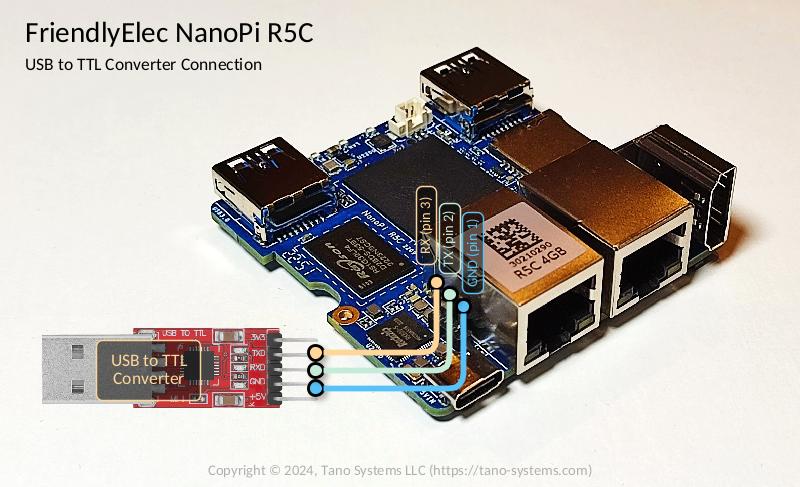
Fig. 3.18 USB to TTL Converter Connection to NanoPi R5C
Serial Setting on Host PC
The default serial console settings for NanoPi R5C for U-Boot and kernel are described in table below.
Parameter |
Value |
|---|---|
Baudrate |
1500000 |
Data bits |
8 |
Stop bits |
1 |
Parity |
none |
Flow control |
none |
Signal level |
3.3 V |
3.9 Default Network Configuration
By default, network port LAN (interface eth1) are joined
into a bridge (br-lan interface).
Bridge br-lan is in the LAN firewall zone. By default, the IP address
on the br-lan bridge is configured using a DHCP client.
To see obtained IP configuration for LAN network use the following command:
[root@tanowrt ~]# ifstatus lan | jsonfilter -e '@["ipv4-address"][0].address'
192.168.0.54
In this example, the device got the IP address 192.168.0.54 via DHCP
on LAN interface (bridge br-lan).
The network port WAN (interface eth0) is a separate network interface
included in the WAN firewall zone with enabled translation (NAT) from LAN zone.
The IP address of the eth0 interface is also configured with a DHCP client.
A firewall with blocking rules for incoming traffic is enabled on the eth0
interface. Therefore, there is no access to the web configuration interface
through this interface.
To see obtained IP configuration for WAN network use the following command:
[root@tanowrt ~]# ifstatus wan | jsonfilter -e '@["ipv4-address"][0].address'
10.10.0.168
In this example, the device got the IP address 10.10.0.168 via DHCP
on the WAN interface (eth0).
Ethernet ports LAN (eth1) and WAN (eth0)
have enabled LLDP by default.
3.10 Web User Interface
The WebUI can be accessed via Ethernet port connection through HTTP(s) protocol. You must see something like this in browser after you logged in:
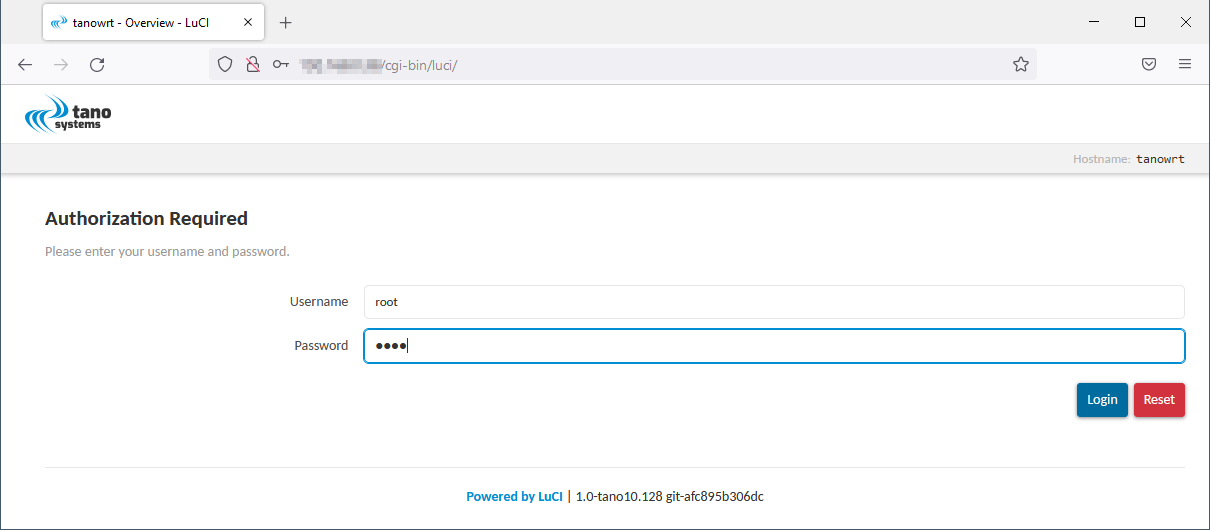
Fig. 3.19 LuCI WebUI Login Page
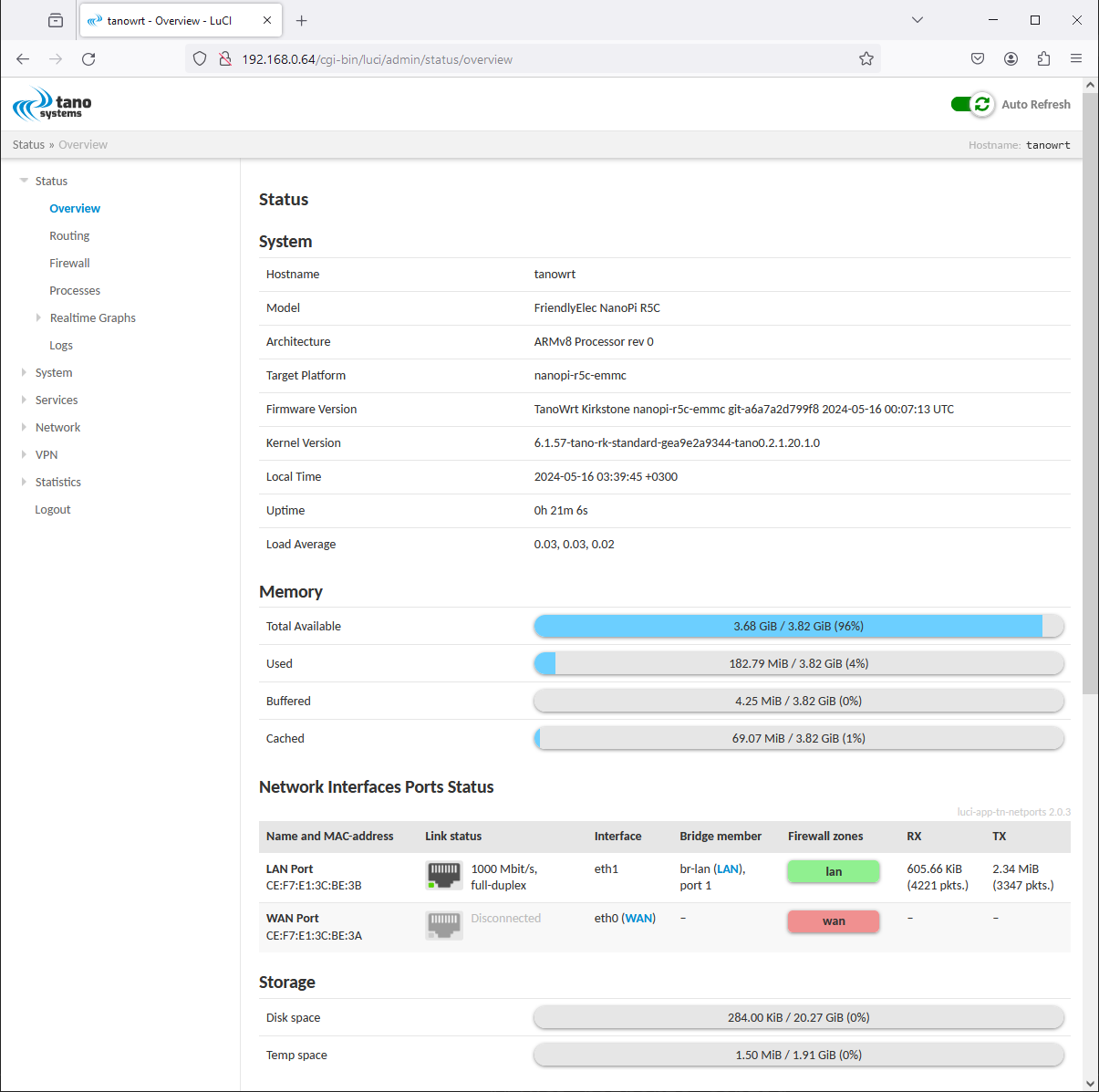
Fig. 3.20 LuCI WebUI Overview Page
3.11 Firmware Upgrade
No special information about firmware upgrade.
Use produced .swu artifact for upgrading running system.
See also
See common instructions in Firmware Upgrade section.
3.12 Additional Information
Here are sections with various additional information about the FriendlyElec NanoPi R5C board and the operation of TanoWrt on it.
